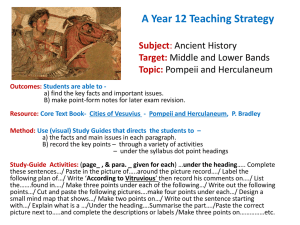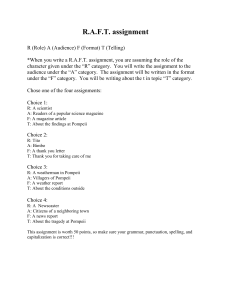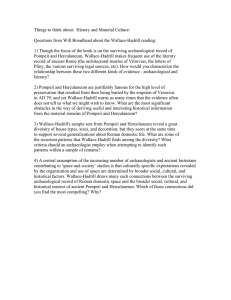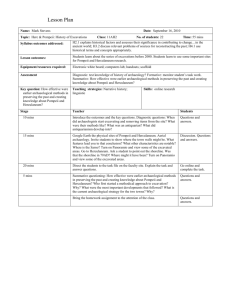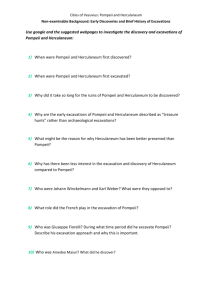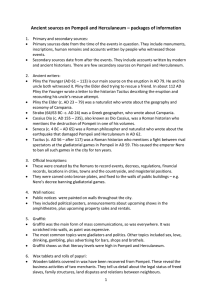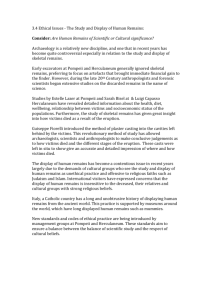Uploaded by
Dante Parisi
Pompeii & Herculaneum Exam: Fiorelli, Forum, Women, Leisure, Religion
advertisement
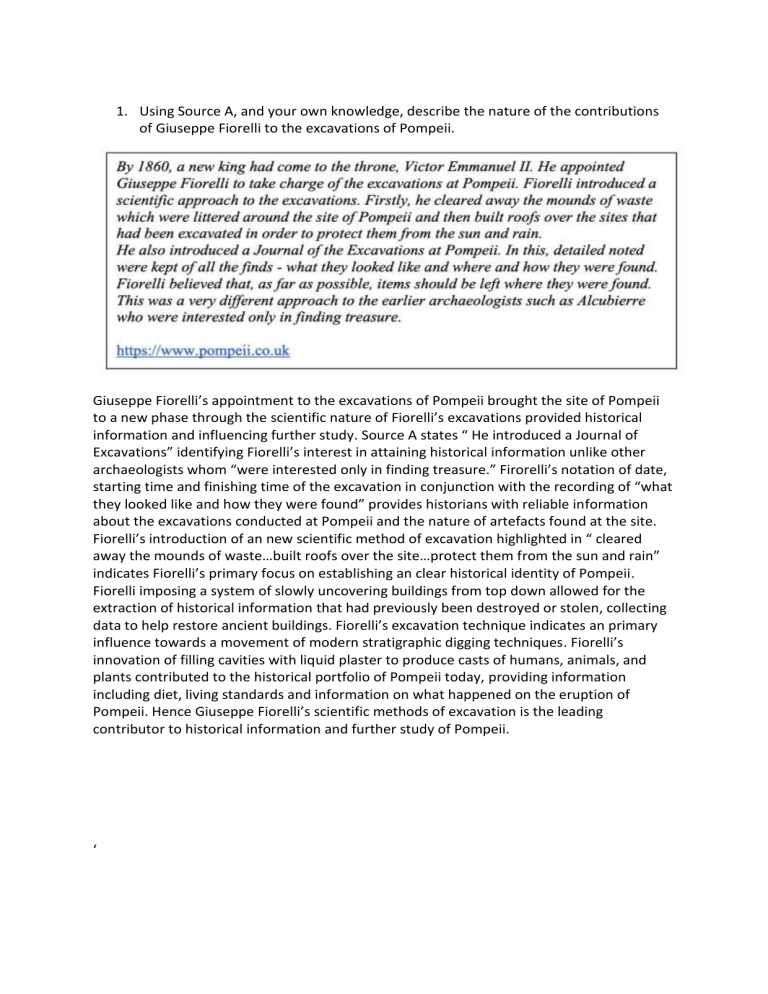
1. Using Source A, and your own knowledge, describe the nature of the contributions of Giuseppe Fiorelli to the excavations of Pompeii. Giuseppe Fiorelli’s appointment to the excavations of Pompeii brought the site of Pompeii to a new phase through the scientific nature of Fiorelli’s excavations provided historical information and influencing further study. Source A states “ He introduced a Journal of Excavations” identifying Fiorelli’s interest in attaining historical information unlike other archaeologists whom “were interested only in finding treasure.” Firorelli’s notation of date, starting time and finishing time of the excavation in conjunction with the recording of “what they looked like and how they were found” provides historians with reliable information about the excavations conducted at Pompeii and the nature of artefacts found at the site. Fiorelli’s introduction of an new scientific method of excavation highlighted in “ cleared away the mounds of waste…built roofs over the site…protect them from the sun and rain” indicates Fiorelli’s primary focus on establishing an clear historical identity of Pompeii. Fiorelli imposing a system of slowly uncovering buildings from top down allowed for the extraction of historical information that had previously been destroyed or stolen, collecting data to help restore ancient buildings. Fiorelli’s excavation technique indicates an primary influence towards a movement of modern stratigraphic digging techniques. Fiorelli’s innovation of filling cavities with liquid plaster to produce casts of humans, animals, and plants contributed to the historical portfolio of Pompeii today, providing information including diet, living standards and information on what happened on the eruption of Pompeii. Hence Giuseppe Fiorelli’s scientific methods of excavation is the leading contributor to historical information and further study of Pompeii. ‘ 2. Using Source B, and your own knowledge, outline the role of the main buildings of the Forum of Pompeii. The primary role of the main buildings associated with the Pompeii’s forum where for administration, religious and commercial functions. Source B identifies the Temple of Jupiter, the main temple in the city that reciprocated the religious identify of the Roman empire. The Temple was built for the residents of Pompeii to worship the mainstream Roman gods Jupiter, Juno and Minerva. Source B identifies the Basilica, initially an area for the administration of justice, the Basilica became vital in the commercial lifestyle of residents living in Pompeii. The Basilica housed Pompeii’s courts yet simultaneously acted as an market in which businessmen would take part in commercial trading. The building played an crucial role in daily business and the local economy of Pompeii. The Municipal offices identified in Source B were vital in the administration of Pompeii as an city. The municipal offices include the Council of Decurions , Office of the Aediles and the Office of the Duumviri. The Office of the Duumviri was the office of the highest authorities of the town usually the magistrates. The Council of Decurions acted as the town council and the Office of the Aediles were responsible for public work or maintenance of the town. Hence the primary role of the main buildings of Pompeii’s forum were for means of administration, religion and commercial activities. The Pompeian forum is an 150 metres long by 40 metres wide rectangular paved area surrounded by a white limestone double colonnaded portico featuring equestrian statues honouring the imperial family. 3. Assess the value and limitations of frescoes and mosaics in understanding the role of women in Pompeii and Herculaneum. In your response refer to Source C and other sources you have studied pG 61, pG 156 Frescos and mosaics provide significant value in understanding the role in women in Pompeii and Herculaneum yet are limited by the lack of information they can possess that other written sources such as inscriptions or wall writings can provide. Frescos and mosaics provide significant value in understanding the role of women in Pompeii and Herculaneum yet are limited by the lack of information they possess that written sources such as inscriptions or wall writings provide on all classes of women. Source C identifies an Fresco highlighting’s Baker Terentius Neo wife with an stylus and wax tablets. The fresco indicates the nature of education of women within Pompeii. It is unknown how many women within Pompeii could read or write yet Source C through dressing the women in prestigious gowns suggests the upper class women were educated by slave tutors within the home. The fresco illustrating the priest of Isis, a cult of one third women identifies the role of women in priesthood and other positions of power within the cult. Hence Fresco’s identifies the ability for women to contribute and hold high positions in religious proceedings in Pompeii and Herculaneum. Frescos are limited in the information they can provide as they are usually of wealthy individuals without the how or why significant women had financial and social emancipation. Written sources from Pliny the Younger highlight the household role of women as “highly intelligent…careful housewife” when describing his wife Calpurnia. The role of household women were to take care of children and manage the home within Pompeii and Herculaneum. Inscriptions and wall writings on women range from Julia Felix and Eumachia to prostitutes. An advertising inscription found on Julia Felix’s shops identifies the role of women as merchants in roman society. Julia Felix’s “ bathing establishment… bars, lock-up shops and rooms” identify the ability for women in Roman society to accumulate large sums of finance and higher levels in status. Graffiti provides information on lower class individuals such as prostitutes that frescos and mosaics cannot provide. Graffiti revelling the names of women who worked in brothels and the service they provided identifies the clear dichotomy in status of women within Pompeian society. Hence Frescos and Mosaics provide some information on the role of wealthy women yet such sources are limited by failing to provide information related to women in written sources. 4. Explain what graffiti reveals about leisure activities in Pompeii and Herculaneum. Support your response with reference to Source D and other relevant sources. Graffiti found in the excavations of Pompeii and Herculaneum indicate the importance of taverns, brothels, baths and the main sites the theatre and amphitheatre as leisure activities in respective cities. Source D identifies Graffiti from the Nucerian Gate indicating an gladiator battle between subjects named as “Princeps” and “Hilarius” revealing the popular leisure activity of watching gladiator battles. Thousands of residents would watch gladiators in the amphitheatre as each battle ensured a different stage of fight. Battles included gladiator style fights, heavily armed and light armed battles to satisfy the blood thirsty displays residents demanded. Source D is located near the Amphitheatre to display the losses and victories fresh into the minds of spectators. Graffiti at the entry of the bathhouse reveals the importance of the bathhouses as an leisure activity. Apelles Caesar crude language and identification of eating through “lunched” in graffiti highlights the specific leisure activates in the baths. Citizens would engage in sexual activates within the bathhouse with men and women as a mean of pleasure. Apart of many individuals daily routine individuals would both relax and eat usually an light snack within the bathhouse. Alternately men would engage in exercise such as bladder ball, read a book or stroll in the gardens. Graffiti found in brothels was common for both Pompeii and Herculaneum. Graffiti found in the Vico d’Eumachia brothel identifies sex as a mean of leisure evident in the graffiti translated to “screwer of women”. In Pompeii and Herculaneum citizens many were obsessed with sex as means of entertainment. Brothels were a symbol of good luck, and location of power or prosperity. Taverns were a location of leisure in Pompeii and Herculaneum through drinking and gambling. The importance of drinking and gambling is evident in the Herculaneum bar where an individual “spent 105 and half sestertii” on drinking, gambling and sexual leisure within the tavern. The leisure activity of attending tragedies and comedy’s in the theatre was common in Pompeian and Herculaneum society. Graffiti at the theatre identifies the respect of the actor Lucius Actius, described by the audience as “Mysticus musician of the comedian Icuus.” Actors in the theatre acted as an output for comedic release and dramatical engagement in order to entertain the residents of Pompeii and Herculaneum. Hence Graffiti located in amphitheatres, theatres, brothels, taverns and bathhouses reveal the diverse nature of leisure in Pompeii and Herculaneum. https://www.pompeiiinpictures.com/pompeiiinpictures/R8/8%2007%2020%20p1.htm 5. What does the evidence reveal about public and private religion in Pompeii and Herculaneum. In your response make reference to Sources E and F and other sources you have studied. Archaeological and literary evidence such as frescos, mosaics, structural remains, artefacts , inscriptions and public notes reveal the polytheistic public and private nature of religion in Pompeii and Herculaneum. Evidence has proved Public religion was an vital facet of the social fabric in Pompeii and Herculaneum for not just the worship of Roman gods but the worship of foreign deities in the participation in foreign cults. Source E identifies the Temple of Apollo in Pompeii an public haven dedicated to the Greco-Roman god Apollo. In Roman religion citizens saw the gods as spirits for all aspects of life such as apollo for music, oracles, archery, medicine and the sun. Evident through Source E Roman religion was concerned with ritual rather than faith as the temple was dedicated to Apollo where rituals would take place carried out by religious bodies to honour and gain the favour of the gods aspect of life. Foreign cults such as the imperial cult and cult of Isis were a common public religious representation in Pompeii and Herculaneum. The imperial cult religious veneration towards the Roman emperor and significant imperial family first introduced in the time of Augusta as a mean of honour. The structural remain of the Temple of Vespasian and the statues of the imperial family provides historians with the understanding the public religion was primary linked to politics. Religious rituals such as the sacrificial banquet were carried out Flamens for the general population. The Cult of Isis indicates the foreign influence of Religion in Pompeii and Herculaneum. A fresco adorned on the Temple of Isis of the priests and priestesses featuring large ceremonies accompanied by music, chanting and the burning of sacrifices identifies the salvation, happiness and consolation from suffering the worship of Isis provoked. The roofless enclosure evident on the remains of the Temple of Isis provided evidence into the Egyptian influence on Pompeian religion. Hence a vital faction of the social fabric of Pompeii and Herculaneum was Public Religion constructed of Roman tradition in conjunction with political campaigns and foreign influences. Literary and Archaeological evidence indicates the importance of Private Religion in Pompeii and Herculaneum in the means of private worship. Source F states “ What is there more holy.. than the house of every individual citizen” highlighting how Private Religion was more prominent and important that Public religion in Pompeian society. The Orations of Marcus Tullius Cicero indicates the most holy location of the household was constructed of “his alters…his hearths… his household gods.” The household gods included the dancing like youths Lares, Penates and the Genius. The protector of the household were the Lares while the penates were the gods honoured for the pantry and Genius was the spirit of the head of house. Every home had a lararium to worship there household Gods. The paterfamilias would gather with his family and make offerings, say prayers for protection and prosperity from significant household gods. All classes of society indulged in Private religion evident in the presence of both forms of the lararium being the remains of the wall niche and aedicule found in Pompeii and Herculaneum. The remains of the aedicule from the House of Vetti identified a snake on the alter an symbol of protection of the hearth an brought fertility. The presence of the figure of Mercury identified how citizens would pray and conducted rituals for everyday preferences such as commerce. Evidence relating to household gods and practices highlight the importance of Private Religion in Pompeii and Herculaneum.

